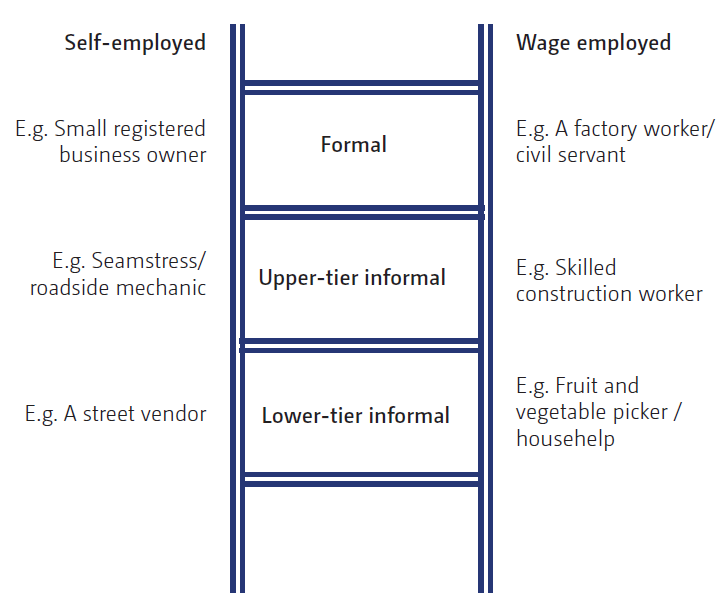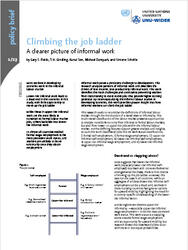Policy Brief
Climbing the job ladder
A clearer picture of informal work
Most workers in developing countries work in the informal labour market
Lower-tier informal work leads to a dead end in the countries in this study, with little opportunity to move up the job ladder
While those in upper-tier informal work are the most likely to transition to formal labour market jobs, others backslide into lower-tier informal work
In almost all countries studied formal wage-employment is the most persistent work status, and workers are unlikely to leave voluntarily once they obtain employment
Informal work poses a persistent challenge to development. This research analyzes patterns of informal work and describes the drivers of low-income, low-productivity informal work. This work identifies the main challenges and constraints preventing workers from transitioning to more stable jobs that provide higher earning potential. By reconceptualizing the informal labour market in developing countries, this work provides greater insight into how informal workers can climb the job ladder.
This research seeks to reconsider the definitions of informal labour market through the introduction of a tiered view to informality. This multi-tiered classification of the labour market presents opportunities to analyse transitions not only from informal to formal labour markets, but also from lower- to upper-tier jobs within the informal labour market. Further defining features support greater analysis and insights, as such this work classifies all jobs into six work status classifications: i) formal self-employment, ii) formal wage employment, iii) upper-tier informal self-employment, iv) lower-tier informal self-employment, v) upper-tier informal wage employment, and vi) lower-tier informal wage employment.
 Dead-end or stepping-stone?
Dead-end or stepping-stone?
Data suggests that lower-tier informal work (especially lower-tier informal self-employed) is a dead-end. Once workers enter arrangements like these, there is little chance of moving up the job ladder. However, this was not the case in all countries. While an aggregate of all data shows that informal self-employment can be a dead-end, workers in these outlying countries had greater options for upward mobility, highlighting the need for a country-specific understanding of the lower-tier informal sector.
Across regions we observe upper-tier informality —especially upper-tier informal wage employment— to be the least persistent work status. This work status is a stepping stone towards formal wage employment and an opportunity for upward mobility, but research shows that downward slides occur with more or less equal probabilities.
Several factors were key to upward mobility:
- Education: Level of educational attainment is a key factor associated with upward transitions into better paying work statuses.
- Gender: Men display higher chances of upward mobility than women. Particularly married men display a higher likelihood to climb the job ladder, while the opposite is true for married women. Moreover, female workers are more likely to stay in self-employment. Considering that self-employment offers more flexible working times, this may reflect a preference or constraint.

Lessons for development actors
These findings provide valuable information to support policymaking decisions. The breadth of data on informal work across a diverse range of countries in Africa, Asia, and Latin America shows a clearer picture of the informal labour market. It also broadens our understanding of the differences in composition of employment in developing countries —particularly for regional organizations working in this area.
Meanwhile, the findings on transition patterns across different formality levels, and the possible factors that may explain them, can guide development actors on how to effectively deal with lower tier informal work, which is still dominant and persistent in many developing countries.
As education was a key factor in climbing the job ladder, policymakers should invest in human capital through general education and vocational training initiatives
Create more entry level jobs in the formal labour market to support the transition from upper-tier informal work to formal employment
Formalize upper-tier informal wage employees by incentivizing formal work arrangements and decreasing costs of social protections
Focus on enhancing the livelihoods of lower-tier informal workers by improving working conditions of the wage employed and enact policy reforms to create an enabling environment for the self employed
Implement labour force surveys to obtain information on occupations of workers that can differentiate between formal, lower-tier and upper-tier informal employment, and between self-employment and wage employment
Further assessments of the patterns and drivers of labour market transitions requires high quality panel data in developing countries. Labour force surveys should differentiate between formal, lower-tier, and upper-tier informal employment, and between self-employment and wage employment with greater accuracy. Further, this panel data needs to follow workers over time with larger representativeness and over longer periods, especially for low-income countries. This data could help national statistical organizations and multilateral development agencies like the World Bank to have a clearer understanding of labour markets in developing countries.
 Join the network
Join the network